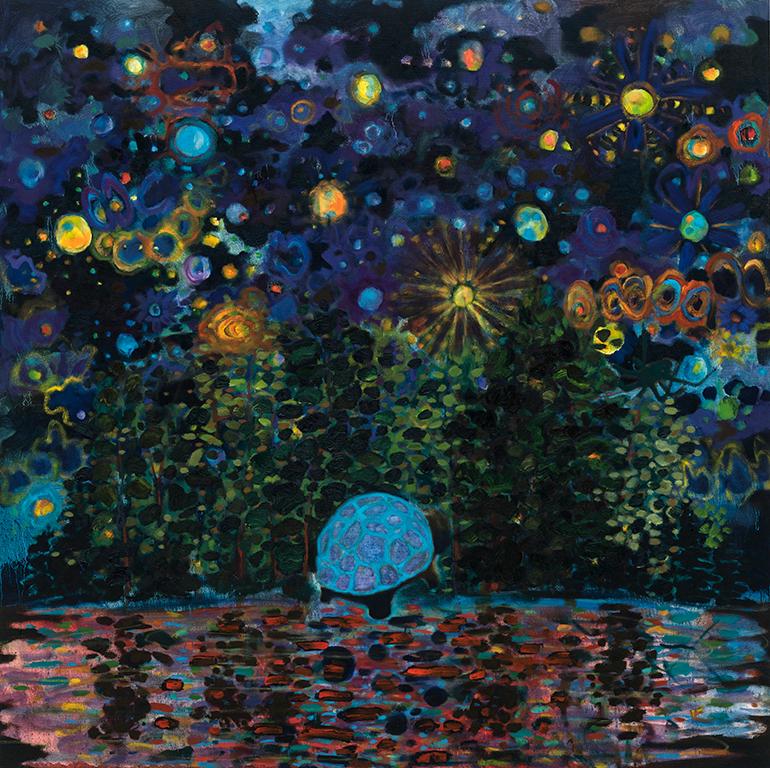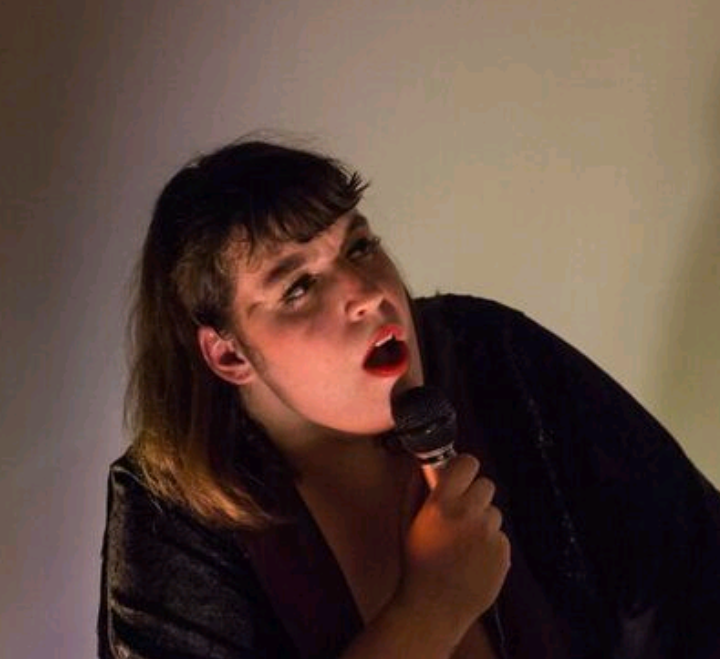I'm pleased to introduce Tess Martens, a new Culture Fancier collaborator. I connected with Tess after seeing her MFA Thesis performance at the University of Waterloo Art Gallery earlier in the spring. Keep an eye on the blog for posts featuring her perspective.
Interview by Tess Martens
I met up with Ben Klein, a friend, mentor and artist who I met at the University of Guelph. He was a Master's of Fine Art candidate at Guelph while I was pursuing an undergrad. We caught up in the beautiful stone courtyard of Pierre-François Ouellette Art Contemporain gallery to talk about his current painting show, Shifter Bender Striker which up until June 16 in Montreal, Quebec.
T: Tell me about your colours.
B: My use of colour is largely intuitive, but also planned to some degree. In the nocturnal scenes I want to depict, it’s about creating a really luminous atmosphere. Each painting has to have real and unreal visual effects that somehow complement each other. So there’s an experimental and a planning side to the colours.
Scout. Oil on canvas. 102 x 102 cm (40" x 40"). 2017
T: Do you ever use references with your animals and landscapes?
B: Not exactly. Lots of things have informed me and influenced me over time, from modernist and contemporary art, to children's illustrations and comics, to myths from all over the world and history. You name it. Cartoons may be in the back of my mind along with paintings. I have taken an interest in lots of different stuff over the years. I’m constructing my own imaginary world. It isn’t primarily theory based or historical, or referential in any definite way. Occasionally, I do make connected, smaller projects like my cover version paintings, from Albrecht Durer for example. But the works in this show are purely imaginative and have no definite sources.
T: I noticed that you add and subtract paint a lot and create almost silhouettes in the sky of animals. (Deities in the sky) Can you talk more about that?
B: There is definitely what you can call subtraction and addition. The process of making the things involves putting in and taking out little elements, and leaving traces and memories of things that are gone in the paintings. Creating little elements and leaving extra hidden moments within the paintings seem to give richness to the results. I am creating these shadowy, possibly spiritual figures, sometimes in the sky floating and observing the world they are a part of. They are not really subtracted or erased, more just painted in a certain way, to seem ephemeral or even a bit ethereal. There is taking off of paint at times, changing what was there before and then repainting. I don’t have the kind of process where subtraction is a main avenue of making the resulting painting but it is part of my toolbox. It is an additive kind of painting in the end that I do, and there are expressive elements as well as slower, more planned elements that take patience and drying time, etc.
Hunter. Oil on canvas. 102 x 127 cm (40" x 50"). 2018
T: Can you talk more about your toolbox of techniques?
B: The work is resolutely from imagination, I don’t work from any sources. However figurative or abstract the pieces are, it’s a process of figuring out and doing it as I go along, using my experience. I know how to make certain kinds of images, surfaces and marks and I learn how to make each piece as I do them over time. I put things together and slowly figure out how they feel right.
T: Everyone asks me this question. When do you feel like a painting is done?
B: It’s hard for me to tell sometimes. Occasionally it is really clear as I am reaching the end. Truth is, most of the time, it is a question of allowing paintings to be open as long as possible. I like paintings to take months of time to finish or longer. I find they absorb a richness that way by all the actual time being allowed to somehow flow into them.
T: For me, I find that there is more thinking than painting that goes into my paintings. What about your process?
B: For sure, I spend a lot of time looking at them and thinking about them as opposed to actually making. The paintings are sometimes fairly big and do take time. I cannot finish a painting in a day even if I work 24 hours. There is a lot of drying time and glazed areas and a lot of areas have to be built up and juxtaposed and somehow unified at some point. I take different kind of risks while making. I have to risk screwing it up several times before it is really strong enough to accept that it is finished. For me if I don’t have some kind of hard won element in my work then I will not be able to fully accept it. Sometimes I wish I was different frankly.
T: What do you mean by “hard won” element?
B: It is a phrase I came across a while back to describe a certain way of painting. “Hard won” in painting as I understand it is something that requires a bit of struggle and angst on the part of the artist. But I don’t want to fetishize that and turn it into a full blown thing. I do find that I just for me personally and experientially can’t believe in my own work unless I do go through this long process that involves the risking of the built up layers of work.
Diver (eclaircie pastorale). Oil on canvas. 127 x 152 cm (50" x 60"). 2018
T: When do you really take risks and break what has come before you?
B: Well, good question. The thing is I want to let every painting have its own unique history of how it’s been made, in a way that is really important to me. I edit and make each piece in a way that is unique to that piece, and in some paintings, the surface is a lot thinner than other pieces that are more dense with painterly areas. It could depend from painting to painting to see through the waiting process for what hasn’t worked. Like in the painting “Striker” which does not have many built up areas. It was just a slow observing waiting process, to see that the layers of transparency were being built into the necessary luminosity. The dreamlike figment of that image in my head came to life eventually. In the painting “Diver” there was really a lot of physical struggle and experimenting with a ton of things that did not work and had to be scrapped off. There is a lot of imagery that has been embedded in there and is mostly no longer visible but is oddly still there, you know?
T: Definitely, I noticed that. I also noticed that some of your animals, I think there is a squirrel or some kind of critter.
B: Some kind of critter.
Navigator. Oil on canvas. 127 x 127 (50" x 50"). 2018
T: Yeah. Do you like labeling your animals or are they different animals on their own?
B: I like the idea that they might seem to be literal actual animals, of whatever kind or what have you, but they really never are. I invent them with ideas of a certain animal in mind to start. If it looks more or less like a tortoise, it pretty much is a tortoise or in the past a ladybug for instance. But the truth is the giraffe and birds and so on aren’t real animals. The critter you are talking about, some people see a mouse, some people see a squirrel, other people see other things.
Caller. Oil on canvas. 106.5 x 137 cm (42" x 54"). 2018
T: There is not that much detail. Is there an intention to that or is it more intuitive?
B: Well, there is an intention to not to pin down the identities of what I am depicting too literally. They should be fully fledged pictorial and imaginative entities. But they have very ambiguous nature to me. I don’t like for things be too clear in the sense of being a naturalistic depiction.
T. Great. Can you talk more about dream and imagination?
B: I am often surprised because I feel that I am a rational person. Well hopefully but I think so as a general rule. I often feel a little surprised how imaginary and dreamlike my work has become but it is something that I really embrace and accept. All these realms/places where reality and unreality touch without being fully explicable, fully described in the cold light of day, in factual terms. That is all stuff that I am really interested in and drives me really powerfully in my work. The work becomes a depictions of things, places, scenes and figures like that, that are always ambiguous to me.
Tracker. Oil on canvas. 127 x 102 cm (50" x 40"). 2018
T: That space in between reality into the imaginary?
B: Almost like an embodiment of the feeling where you don’t know if you are asleep or awake, or maybe a vision of another world or the spirit world. Maybe the paintings are depictions of the spirit world, maybe they’re self aware theoretical imaginations of such a place. The fact that I cannot be absolutely sure even though I don’t claim any objective truth to the spirit world that I am looking for. The fact that that is there is a driving factor.
T: Last question, you have been in Montreal for a while now and now you are moving to New York City. What are you plans?
B: I am a dual citizen, American and Canadian. I do love Montreal and I also enjoyed Ontario where I met you. New York is a very exciting place for an artist to live for a while and I am an American citizen and so is my wife, and we thought that we will go and live there for a while. I am really excited to be surrounded by the New York museums and galleries and have more constant access to them to what I have had in the past. I want to just go to the MET and look for a few hours at just one room instead of having to run through the entire museum in those few hours. I have a few friends there and I’ve been in and out of the States on a number of occasions and now I figured I would spend a bit more time there.
T: Thank you. Congratulations on your show! Best of Luck!
Ben Klein's website
If you liked this post, please like, comment, and share.
About Tess
You can spot Tess Martens performing with all her heart during karaoke night because she has to compensate for her singing voice or cracking jokes at a music open mic night. She is a performance artist and painter that exploits her vulnerabilities and humour. When she is not doing art, she is working with seniors. She recently received her Masters of Fine Art at the University of Waterloo. She now resides in Waterloo, Ontario. Follow Tess on Instagram.








